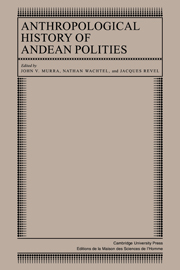Book contents
- Frontmatter
- Contents
- List of contributors
- Preface
- Introduction
- Part I Ecology and society
- Part II The ethnic group and the state
- Part III Systems of classification
- Part IV Symbolic representations and practices
- 11 Inka dynasty and irrigation: another look at Andean concepts of history
- 12 Urco and uma: Aymara concepts of space
- 13 Mirrors and maize: the concept of yanantin among the Macha of Bolivia
- 14 From asymmetry to triangle: symbolic transformations in northern Potosí
- Part V From ethnic polities to communities
- Bibliography of published source
- Index
14 - From asymmetry to triangle: symbolic transformations in northern Potosí
Published online by Cambridge University Press: 05 October 2010
- Frontmatter
- Contents
- List of contributors
- Preface
- Introduction
- Part I Ecology and society
- Part II The ethnic group and the state
- Part III Systems of classification
- Part IV Symbolic representations and practices
- 11 Inka dynasty and irrigation: another look at Andean concepts of history
- 12 Urco and uma: Aymara concepts of space
- 13 Mirrors and maize: the concept of yanantin among the Macha of Bolivia
- 14 From asymmetry to triangle: symbolic transformations in northern Potosí
- Part V From ethnic polities to communities
- Bibliography of published source
- Index
Summary
In studying the system of representations of Andean peoples, the major symbolic preoccupations and overall cultural repertoire have first to be established. The work of the last decade or so, both ethnographic and ethnohistorical, has gone a long way toward achieving this aim; however, as the general contours of the symbolic structure are made precise it becomes both possible and necessary to extend the analysis to the variations of each locality and ethnic group. Insofar as we can talk of Andean symbolic structures, this simultaneously implies that there are transformations within the general structures. In what follows I shall draw on Tristan Platt's work (see Chap. 13, this volume) to discuss such variation in symbolism between two neighboring ethnic groups of northern Potosi, Bolivia. Following on directly from Platt's study of the Macha, I made a study of the Laymi – an Aymara-speaking group numbering in all about eight thousand, whose borders touch those of the Macha at their northeastern end. One of my aims is, then, to document the forms of ethnic variation.
Early European observers were impressed by the systematic ways in which Andean groups proclaimed their identity. According to various sources, the Inka decreed that each ethnic group within the empire have a distinctive appearance. The utility of such a regulation is obvious in a world where obligations of the individual to the state were assessed by ethnic group, and where geographical mobility outside a given region was forbidden without express permission (see Cobo [1653], 1956; Bk. 12, Chap. 26, p. 117).
- Type
- Chapter
- Information
- Anthropological History of Andean Polities , pp. 260 - 280Publisher: Cambridge University PressPrint publication year: 1986
- 15
- Cited by

